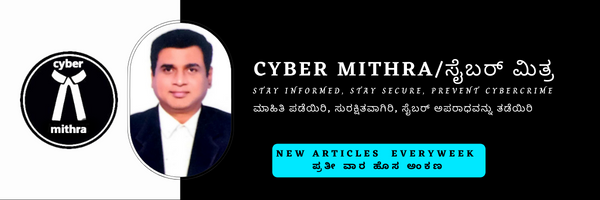Cybercrimes targeting Women and Girls(Part 3)
From last two weeks, I have been writing about various cybercrimes targeting women and girls, how they work, how one can protect oneself from it and what legal or other remedies are available to the victims. In last two weeks, I discussed about cyber stalking, cyber defamation, cyber harassment, Voyeurism and Revenge Porn, Please refer to www.cybermithra.in for knowing more about those cybercrimes. This week, I will discuss two more cyber crimes targeting women and girls namely Doxxing and Catfishing.
How these cybercrimes against women and girls are carried out :-
- Doxxing or doxing : Doxxing is publishing someone’s data online without their consent or exposing someone’s anonymous real identity online. The data published may include personal and financially sensitive information apart from that it can include their current location and travel plans. It can be very dangerous as this is a serious violation of victim’s privacy and can be used for tracking or attacking the victim by her adversaries. Doxxers collect information about people scattered across the internet, then assemble those small pieces of information to reveal the real person behind an alias. Motive for such cybercrime may include jealousy, obsession, revenge, hatred or to humiliate and intimidate the victim or as simple as making profit by selling that data.
- Catfishing : Catfishing is a type of deceptive activity where a person creates a fake identity on a social network account, usually targeting a specific victim for abuse, deception, fraud and various other gains. It is a specific case of impersonation cyber crime(which I had explained in detail in my previous article) and is usually employed for romance scams on dating or matrimonial websites, where they fabricate online identities and curate multiple social media accounts to trick people into emotional or romantic relationships and then use this to commit other cybercrimes. Here the target generally include teenagers, young women, ex-girlfriends or celebrities. Motive for such cybercrime may include low self-esteem, jealousy, obsession, revenge, hatred or as simple as financial gains.
How to protect oneself from such cybercrimes :-
- Keep your social media profile locked or private.
- Do not accept friend requests without proper checking their background.
- Do not share your personal and sensitive information including pictures of where you travel or your loved ones in public space, if you want to share with known friends and family only.
- Protect your private pictures and videos and delete all the copies of it as soon as you get separated.
- Use good antivirus and a firewall software and keep it always updated.
- Do not share your location or travel plans in public.
- Do not respond to strangers messages and block immediately if you are suspicious of them.
- Never, try to meet a person with whom you’ve interacted only online without taking somebody else along and such meeting must always be in a public place.
- Always use strong passwords and keep changing them often.
If you are a victim of such cybercrime :-
Immediately call 1930 cyber helpline or file a complaint at cybercrime.gov.in. Complain to the relevant authority or social media website about such fraudsters and the fraud. Block that user but do not delete any information, instead save them as they will be needed as evidence to prosecute the criminal. If you had installed any software or clicked a hyper link or scanned a QR code provided by fraudster, then uninstall that software, change the passwords/pins of all your important accounts like banking, email etc. Best is to factory reset or format your device as your antivirus may also sometimes fail to find the malware.
Remedies available to victim legally(India) :-
Lodge a complaint at nearby cyber or regular police station under :
- Section 354 A to D(online abuse or crimes against women in cyberspace), Section 378(Theft), Section 424(extract data illegally), Section 441(criminal trespass), Section 499(defamation), Section 500(punishment for slander), Section 503(Threats to harm a person’s reputation), Section 507(Criminal Intimidation), Section 509(Insult privacy and modesty) of Indian Penal Code(IPC)
- Section 43 (Penalty and compensation for damage to computer, computer system, etc), section 66 (punishment for computer related offences – data theft, transmitting virus into a system, destroying data, hacking, or denying access to the computer or network to an authorized person), section 66C(penalties for identity theft and states that anyone who fraudulently or dishonestly uses a person’s identity information), Section 66D (punishment for fraud by impersonation using computer resources), Section 67(publish, transmit, or cause the distribution of obscene content), and Section 67A(publishing, transmission, or facilitating the transfer of sexually explicit content) of The Information Technology Act 2000/08
- Other than this relevant sections from The Immoral Traffic Prevention Act,1956 and Protect children from sexual abuse (POCSO) Act,2012

